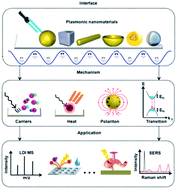Design of plasmonic nanomaterials for diagnostic spectrometry
Abstract
Molecular diagnostics relies on the efficient extraction of biomarker information from the given bio-systems. Plasmonic nanomaterials with tailored structural parameters are promising for the development of biomarker assays due to enrichment effect and signal enhancement. Herein, we overview the recent progress on the development of plasmonic nanomaterials for diagnostic spectrometry, encompassing the interface, mechanism, and application of these materials. For interface, we summarized the types of plasmonic nanomaterials used as interfaces between different materials and light. For mechanism, we descirbe the key parameters (e.g., hot carriers and heat) that characterize the plasmonic effect of materials. For application, we highlighted recent advances in matrix assisted laser desorption/ionization mass spectrometry (MALDI MS) and surface enhanced Raman spectroscopy (SERS) toward precision in in vitro and in vivo diagnostics. We foresee the upcoming era of precision diagnostics by nano-assisted spectrometry methods in both academy and industry, which will require the interest and effort of scientists with diverse backgrounds.

- This article is part of the themed collection: Recent Review Articles


 Please wait while we load your content...
Please wait while we load your content...